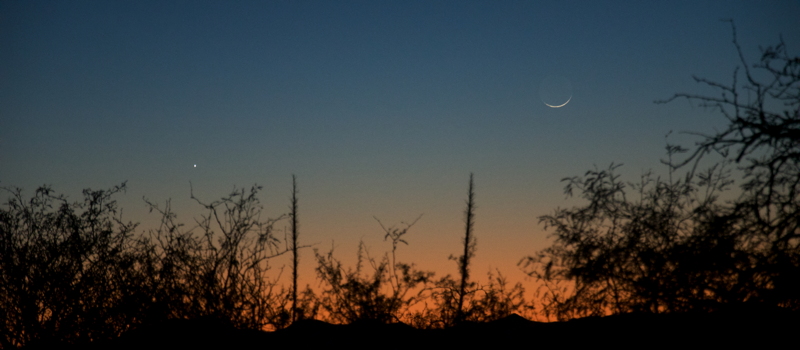Venus & Crescent Moon, Visual Tests of Donated Vixen Telescope,
Some DSO Observing
Posted: 23 December 2014
Clouds ended my previous daytime sun viewing session on 20 December, and they continued into the night. Cloudy skies continued until Monday, 22 December. Received the Right Ascension motor drive for the donated Vixen telescope that I mentioned on my previous report. Installation went fine. No battery pack was provided so the Park will have to purchase one. But at least with clear skies Monday night I would be able to check out the Vixen refractor optics.
|
Open: Monday, 22 December 2014, 1808 MST Temperature: 55°F |
Session: 756 Conditions: Clear, very breezy |
On my way to the observatory I saw this nice pairing of Venus and the crescent moon low in the western sky (handheld Nikon D7000 DSLR, f/5.6, 1/15sec, ISO 2500, FL 105mm):

Earthshine is visible in the photo.
I set up the Vixen A80Mf Refractor Telescope on the observatory patio:

1822 MST: first viewed Mars through the 8" LX200-ACF, 83X. The view of the planet and stars was rather fuzzy, although there were no clouds seen and Mars was not very low in the sky.
I then began working with the Vixen telescope. I focused and aligned the finderscope using Mars. I then viewed Mars using the supplied 20mm eyepiece (45X); nice view. Using its 6.3mm eyepiece (144X) the view was also fuzzy (I guess seeing was really that bad). I swapped from the supplied star diagonal to the supplied visual back and used both eyepieces. Similar views to that with the diagonal. I did notice that reaching the Right Ascension slow motion control was a little difficult while looking through the telescope when using the visual back. Both the RA and Declination slow motion controls provided smooth movement. The rack-n-pinion focuser was also smooth to use and there is a screw to lock the focus position. I swapped back to the diagonal and I moved the telescope to M57 (Ring Nebula) using the finderscope. The view at 45X was very nice and the nebula was easily seen. At 144X, the nebula was fainter but still visible. I then viewed the Double Cluster at 45X. Very impressive view with both clusters in the same field-of-view (FOV). Stars were sharp all the way to the FOV edge. Also viewed M45 (Pleiades) at 45X. Again a nice view, with all the stars of the Pleiades in the FOV.
1855 MST: I noticed that the Zodiacal Light was visible rising from the southwestern horizon. Always nice to see it from Cassiopeia Observatory.
1902 MST: ended Vixen tests and returned to the Meade 8" in the observatory. I wanted to get on with my planned observing and imaging (that had been much delayed due to cloudy nights). SYNCed the observatory clock to WWV. Slewed to NGC1514 (planetary nebula) and viewed it at 83X. It was unimpressive; small and faint. Then viewed M1 (Crab Nebula), 83X. That view was much more impressive (although seeing was not very good).
1921 MST: still very breezy. Began trying to view more Carbon Stars from the list in a recent Sky & Telescope article. Viewed VX Andromedae, but no red star was seen when trying to view TX Piscium.
Next, tried to view some Fornax Galaxies (NGC1097, NGC1365, and NGC1316), low in the southeastern sky. They were too low in the sky and the seeing was not good enough for good viewing. Only the brightest two (NGC1365, and NGC1316) were visible but the view was not good. Tried for NGC2174 (Monkey Head Nebula in Orion); some nebulosity might have been faintly visible at 83X, although it was difficult to be certain I was seeing nebulosity. Seeing was really very bad; stars would frequently swell up and go fuzzy. I decided to not try any DSO imaging this night due to the poor seeing.
1955 MST: viewed M42 (Great Orion Nebula), 83X. Seeing was still very bad. The Trapezium stars would frequently blur together. Humidity was 53% and there were still frequent strong breezes. For such a nice clear night, the poor seeing was disappointing. This was the worse seeing I have ever experienced from Cassiopeia Observatory on a clear night.
2005 MST: tried for two more Carbon Stars: R Leporis and BL Orionis. Neither were seen at the coordinates in the article.
2015 MST: returned to the Vixen telescope and viewed M42 at 45X. Another nice view (even with poor seeing) through the Vixen refractor.
Then went back to the 8" telescope and slewed it to Comet C/2014 Q2 (Lovejoy). It was well below the hill to the southeast at this time.
Due to the really lousy seeing, I decided to end this session.
|
Close: Monday, 22 December 2014, 2035 MST Temperature: 47°F |
|
Comments are welcome using Email. If you are on Twitter you can use the button below to tweet this report to your followers. Thanks.
Cassiopeia Observatory Home Page
Copyright ©2014 Michael L. Weasner / mweasner@me.com
URL = http://www.weasner.com/co/Reports/2014/12/23/index.html
